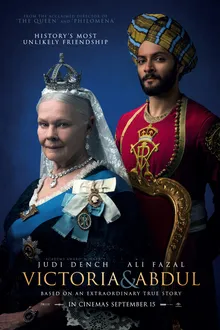Historical accuracy of Victoria & Abdul

Historical accuracy of Victoria & Abdul

Characters
Queen Victoria
Based on the real Queen Victoria in her later years. Judi Dench's portrayal captures her known characteristics: loneliness, imperiousness, and her documented deep affection and reliance on Abdul Karim.
Abdul Karim (The Munshi)
Based on the real Abdul Karim. Ali Fazal portrays his journey from servant to the Queen's confidant and Munshi (teacher), reflecting the historical trajectory, though his personal ambitions might be softened.
Mohammed Bux
Based on the real Mohammed Bux who traveled to England with Karim. His character provides contrast and commentary on Karim's rising status, though his personality is likely dramatized.
Sir Henry Ponsonby
Based on the real Sir Henry Ponsonby. Eddie Izzard portrays his role accurately as part of the Royal Household deeply concerned and opposed to Karim's influence over the Queen.
Bertie, Prince of Wales
Based on the future King Edward VII. Accurately portrayed leading the Royal Family's and Household's opposition to Karim, motivated by prejudice and jealousy. Played by Eddie Izzard.
Dr. James Reid
Based on the real Sir James Reid. Accurately depicted as part of the household concerned about Karim's influence and Victoria's health/judgment.
More characters
Lady Churchill
Based on Jane Spencer-Churchill, Baroness Churchill, representing the ladies of the court and their reactions to Karim's presence and favour.
Giacomo Puccini
Based on the real composer, accurately shown performing for Queen Victoria during her trip to Florence.
Lord Salisbury
Based on the real Lord Salisbury, accurately depicted interacting with the Queen regarding the political implications and household conflict surrounding Abdul Karim.
Harriet Phipps
Based on the real Harriet Phipps, one of Victoria's confidential attendants involved in managing household affairs.
Story
Karim sent to England for Golden Jubilee (1887)
Abdul Karim and Mohammed Bux were genuinely selected and sent from Agra, India, to serve Queen Victoria during her Golden Jubilee celebrations.
Victoria takes special notice of Karim
Historical accounts and Victoria's own journals confirm she was quickly intrigued by Karim, distinguishing him from other servants.
Karim becomes Victoria's Munshi (teacher)
Victoria appointed Karim as her Munshi, and he taught her Hindustani (Urdu) and educated her about Indian culture and affairs for many years, as depicted.
Development of a close, controversial friendship
Victoria's journals and surviving correspondence confirm an exceptionally close and affectionate relationship that lasted 14 years, considered highly unconventional and controversial at the time.
Opposition from Royal Household and Family
The film accurately portrays the intense dislike, jealousy, and racial/social prejudice Karim faced from the Royal Household and members of the Royal Family, including Bertie (Edward VII).
Victoria defends Karim staunchly
Victoria vigorously defended Karim against the Household's attempts to discredit or dismiss him, threatening them and insisting on his inclusion in court life, as shown in the film.
Karim teaches Victoria Urdu and about India/Islam
Victoria learned Urdu from Karim over 13 years, filled journals in the script, and discussed Indian affairs and religion with him.
Karim granted titles, land, privileges
Victoria bestowed numerous honours, titles, land grants in India, and significant privileges upon Karim, elevating his status far above that of a servant, causing much resentment.
Trip to Florence including Karim
Victoria did travel to Florence, Italy, and insisted Karim accompany her, despite household objections, as depicted.
Household investigates Karim's background in India
The Royal Household did investigate Karim's family origins in India, hoping to find information to discredit him with the Queen (discovering his background was more humble than perhaps initially implied).
Exact nature of personal relationship
The film depicts a deep, loving, mother-son like platonic bond. While their closeness is documented, the precise emotional nature remains debated. Most historians find no evidence of a physical/romantic relationship.
Victoria threatens abdication over Karim row
While perhaps slightly dramatized, Victoria did threaten drastic action (like refusing to attend state events) if her household did not treat Karim with respect, showing the depth of her defense.
Bertie orders destruction of papers after death
After Queen Victoria's death in 1901, her son King Edward VII (Bertie) ordered the confiscation and burning of correspondence between Victoria and Karim to erase evidence of their close relationship.
Karim sent back to India after Victoria's death
Shortly after Victoria's death and the destruction of records, Karim was dismissed from court and sent back to India, where he lived on the estate Victoria had arranged for him until his death in 1909.
Setting
Late Victorian Era Britain (1887-1901)
The film effectively captures the atmosphere, social mores, and visual style of Britain during the final decades of Queen Victoria's reign.
Royal Residences (Windsor, Balmoral, Osborne House)
Filmed partly at Osborne House and using other locations to represent Windsor and Balmoral, the settings accurately evoke the grandeur and specific environments of Queen Victoria's court life.
Royal Court Life and Hierarchy
Portrays the rigid protocols, social stratification, and internal politics within the Royal Household, highlighting the shock caused by Karim's integration into Victoria's inner circle.
Costumes (Royal, Household, Indian Attire)
Costumes are meticulously designed, accurately reflecting late Victorian royal fashion (including Victoria's mourning black), household livery, and traditional Indian clothing worn by Karim.
Florence, Italy (Royal Visit)
Accurately portrays Florence as a destination for Victoria's travels and depicts the type of cultural events (like Puccini's performance) she might attend.
Colonial Attitudes / Racism
Effectively portrays the prevalent racial prejudice and social snobbery faced by Karim from the British establishment, reflecting the colonial mindset of the era.
Depiction of India (Agra - brief)
India is shown briefly at the beginning and referenced throughout. While visually adequate, the focus is primarily on the British setting.
Communication methods (Letters, Journals)
Reflects the importance of written correspondence and journaling (Victoria's Hindustani journals, Karim's diary) as primary forms of communication and record-keeping during the period.
